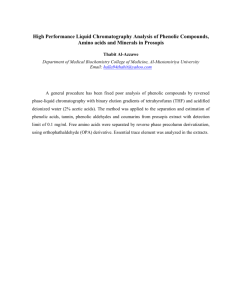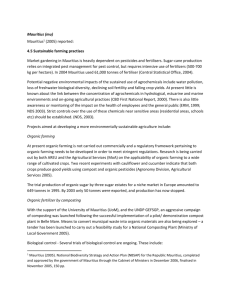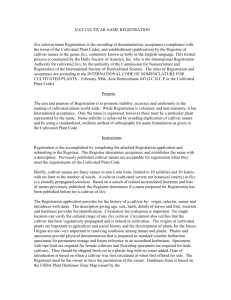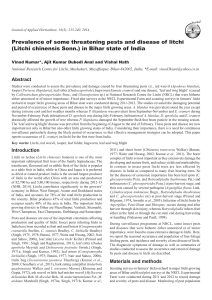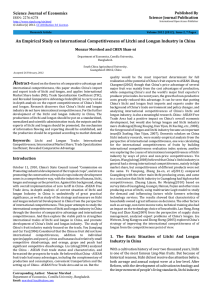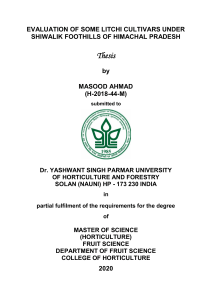chemotaxonomic markers and microsatellites
advertisement
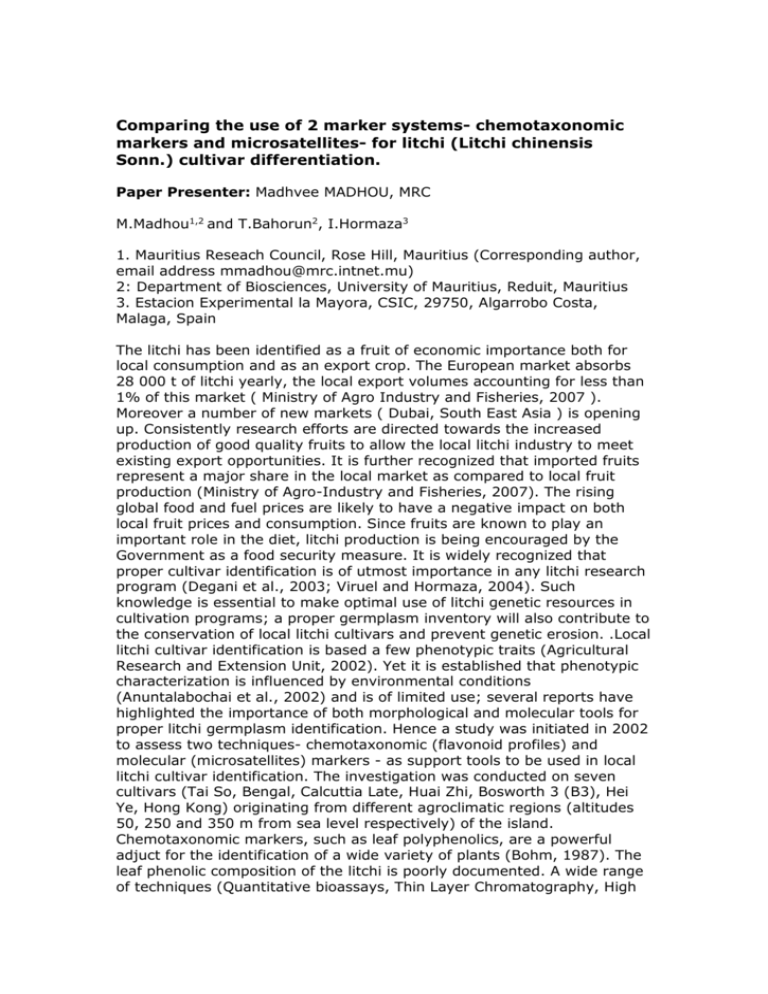
Comparing the use of 2 marker systems- chemotaxonomic markers and microsatellites- for litchi (Litchi chinensis Sonn.) cultivar differentiation. Paper Presenter: Madhvee MADHOU, MRC M.Madhou1,2 and T.Bahorun2, I.Hormaza3 1. Mauritius Reseach Council, Rose Hill, Mauritius (Corresponding author, email address mmadhou@mrc.intnet.mu) 2: Department of Biosciences, University of Mauritius, Reduit, Mauritius 3. Estacion Experimental la Mayora, CSIC, 29750, Algarrobo Costa, Malaga, Spain The litchi has been identified as a fruit of economic importance both for local consumption and as an export crop. The European market absorbs 28 000 t of litchi yearly, the local export volumes accounting for less than 1% of this market ( Ministry of Agro Industry and Fisheries, 2007 ). Moreover a number of new markets ( Dubai, South East Asia ) is opening up. Consistently research efforts are directed towards the increased production of good quality fruits to allow the local litchi industry to meet existing export opportunities. It is further recognized that imported fruits represent a major share in the local market as compared to local fruit production (Ministry of Agro-Industry and Fisheries, 2007). The rising global food and fuel prices are likely to have a negative impact on both local fruit prices and consumption. Since fruits are known to play an important role in the diet, litchi production is being encouraged by the Government as a food security measure. It is widely recognized that proper cultivar identification is of utmost importance in any litchi research program (Degani et al., 2003; Viruel and Hormaza, 2004). Such knowledge is essential to make optimal use of litchi genetic resources in cultivation programs; a proper germplasm inventory will also contribute to the conservation of local litchi cultivars and prevent genetic erosion. .Local litchi cultivar identification is based a few phenotypic traits (Agricultural Research and Extension Unit, 2002). Yet it is established that phenotypic characterization is influenced by environmental conditions (Anuntalabochai et al., 2002) and is of limited use; several reports have highlighted the importance of both morphological and molecular tools for proper litchi germplasm identification. Hence a study was initiated in 2002 to assess two techniques- chemotaxonomic (flavonoid profiles) and molecular (microsatellites) markers - as support tools to be used in local litchi cultivar identification. The investigation was conducted on seven cultivars (Tai So, Bengal, Calcuttia Late, Huai Zhi, Bosworth 3 (B3), Hei Ye, Hong Kong) originating from different agroclimatic regions (altitudes 50, 250 and 350 m from sea level respectively) of the island. Chemotaxonomic markers, such as leaf polyphenolics, are a powerful adjuct for the identification of a wide variety of plants (Bohm, 1987). The leaf phenolic composition of the litchi is poorly documented. A wide range of techniques (Quantitative bioassays, Thin Layer Chromatography, High Pressure Liquid Chromatography) was used to provide a comprehensive picture of the leaf phenolic profile of different cultivars. Phytochemical data revealed that litchi leaves are particularly rich in flavanol and flavonoid derivatives while phenolic acids were detected at lower levels. However a significant degree of qualitative and quantitative variation was detected among cultivars. Quantitative bioassays showed that the total phenolic, total proanthocyanidin and total flavonoid contents of the extracts varied widely among cultivars. B3, Bengal and Huai Zhi recorded high total phenol ( over 40 mg Gallic Acid/g dw ) and high flavonoid contents ( over 25 mg Quercetin/g dw ). It was also observed that the cultivars ‘ Hong Kong ’ and ‘ Hei Ye ’ had lowest amounts ( less than 20 mg/g dw ) of the three classes of phenolic compounds.Consistently detailed qualitative and quantitative analysis using Thin Layer Chromatography and High Pressure Liquid Chromatography revealed that cultivars with highest concentrations of phenolic compounds also recorded complex phenolic profiles, in terms of composition and prominence. Based on these variations cultivars were classified in decreasing order of complexity: Huai Zhi > Yook Ho Pow > B3 > Bengal, Calcuttia Late > Tai So ( from altitudes 250 and 350 m) > Hei Ye , Hong Kong > Tai So ( altitude 50 m) It was difficult to differentiate among profiles of firstly, Calcuttia Late and Bengal and secondly, Hong Kong and Hei Ye . This is an indication that these could be two cases of synonymies with similar genotypes bearing different names. Interestingly the Tai So leaf extracts from the lowest altitude had poorer profiles than other Tai So extracts suggesting the presence of two genotypes classified under that cultivar name. Microsatellites are tandem repetitions of 1-6 bp nucleotide motifs found in all genomes analysed to date and have been extensively used in cultivar identification of many fruits (Wunsch and Hormaza, 2002). Twelve pairs of litchi microsatellites (Viruel and Hormaza, 2004) were used to investigate the genetic relationships among cultivars. It was revealed that all the studied Tai So accessions had identical SSR profiles despite the observed chemotaxonomic variations. Observations made in other plant species have shown that plant phenolic composition can be influenced by the environment (Alonso-Amelot, 2004; Mimura et al., 2004); it was concluded the litchi leaf flavonoid profiles could be influenced by the different environmental conditions prevailing at the lowest altitude. Consistently with leaf flavonoid profiles similar SSR profiles were obtained for firstly Calcuttia Late and Bengal, and secondly Hei Ye and Hong Kong, hence revealing two cases of synonymies of litchi cultivar nomenclature. In this case it could be deduced that chemotaxonomic profiles are good indicators of genetic similarity. However due the variations obtained among Tai So accessions from different climatic zones it was concluded that litchi leaf phenolic profiles can be used as an identification tool when all accessions originate from the same environmental conditions. In case accessions originate from various regions the use of a more precise marker such as microsatellites is recommended. Keywords: Litchi, cultivar identification, chemotaxonomic markers, Microsatellites References Alonso-Amelot, M E., Aberto O., Calcagno- Pisarelli, M.P .(2004). Phenolics and condensed tannins in relation to altitude in neotropical Pteridium spp A fieldstudy in the Venezuelan Andes. Biochemical Systematics and Ecology 32, 969-981. Anuntalabhochai, R., Chundet R., Chiangda, J, Apavatjrut, P (2002). Genetic diversity within lychee based on RAPD analysis. Acta Horticulturae 575, 253-259. Agricultural Research and Extension Unit (2002). Litchi in Mauritius. Production, Processing and Export. Published by AREU/FARC, Sep 2002. Bohm, B.A (1987). Intraspecific flavonoid variation. The Botanical Review 53(2), 197-279. Degani, C., Deng, J., Beiles, A., El-Batsri, R., Goren, M. and Gazit, S. (2003). Identifying Lychee Cultivars and their Genetic relationships Using Intersimple Sequence Repeat Markers. Journal of the American Society of Horticultural Science. 128 (6), 838-845. Mimura, R.M., Salatino, A. and Salatino, M.L.F. (2004).Distribution of flavanoids and the taxonomy of Huberia (Melastomataceae). Biochemical Systematics and Ecology 32, 27-34. Ministry of Agro-Industry and Fisheries (2007). Strategic Options in Crop Diversification and Livestock Sector (2007-2015). Published by Ministry of Agro-Industry and Fisheries, Republic of Mauritius. Viruel, M.A and Hormaza J.I (2004). Development, characterization and variability analysis of microsatellites in lychee . Theoretical and Applied Genetics 108, 896-902. Wunsch, A.and Hormaza J.I. (2002). Cultivar identification and genetic fingerprinting of temperate fruit tree species using DNA markers. Euphytica 125,59-67.


